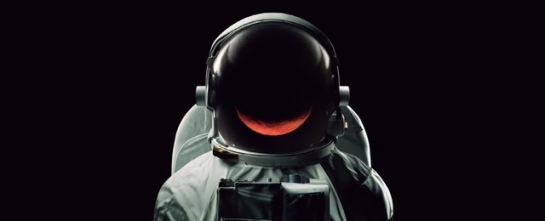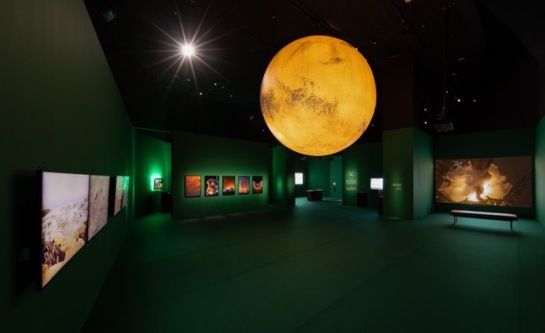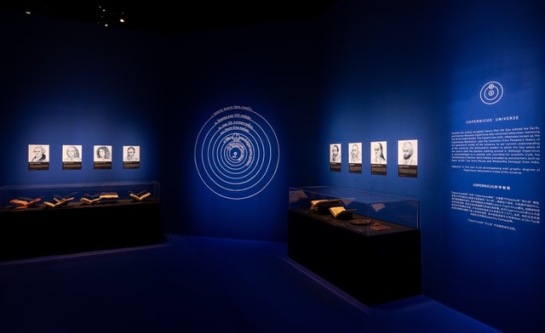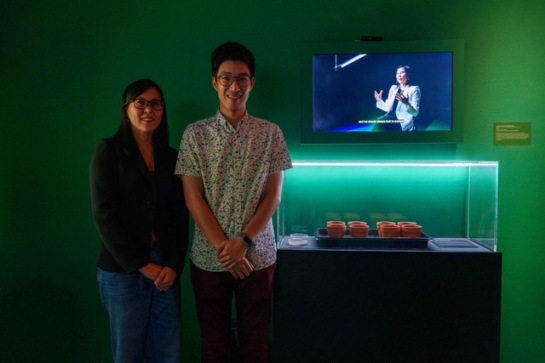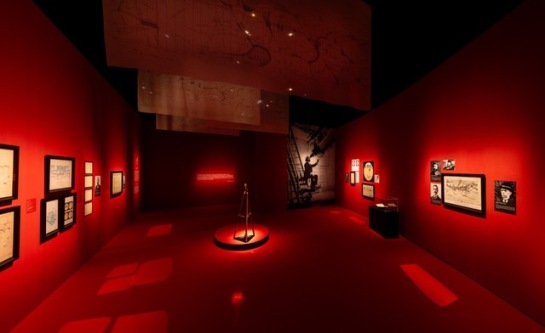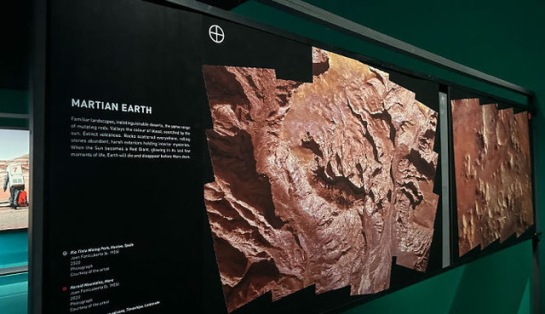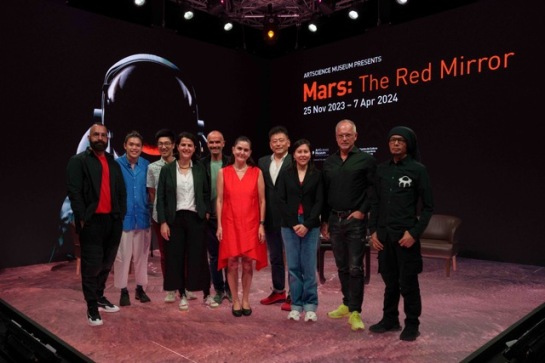Mars: The Red Mirror
An exhibition at ArtScience Museum
29 February 2024
In November 2023, ArtScience Museum opened an exhibition called Mars: The Red Mirror (25 November 2023 – 7 April 2024). Mars: Red Mirror takes visitors on an expedition through history and across cultures to learn how our neighbouring planet has been seen and understood through time. It features over 300 objects, including rare scientific manuscripts, sculptures, historical artefacts, films, an authentic Martian meteorite and contemporary art.
The website is here: https://www.marinabaysands.com/museum/exhibitions/mars.html
Below is the introduction I wrote for the exhibition catalogue.
Installation shot of Mars: The Red Mirror, ArtScience Museum
Mars: The Red Mirror – An Introduction
by Honor Harger, February 2024
“The beauty of Mars exists in the human mind. Without the human presence it is just a collection of atoms, no different than any other random speck of matter in the universe. It’s we who understand it, and we who give it meaning. All our centuries of looking up at the night sky and watching it wander through the stars. All those nights of watching it through the telescopes, looking at a tiny disk trying to see canals in the albedo changes. All those sci-fi novels with their monsters and maidens. And all the scientists who studied the data, or got us here. That’s what makes Mars beautiful.”
– Kim Stanley Robinson, Red Mars (1992)
The exhibition, Mars: The Red Mirror, explores our connection to the planet Mars, synthesising 12,000 years of culture, art, history and science, from ancient times to the present day.
Capturing our imagination like no other planet, Mars has fascinated humanity for millennia. Mars: Red Mirror takes visitors on an expedition through history and across cultures to learn how our neighbouring planet has been seen as the god of war, an ancestral symbol for masculinity and a muse for science fiction. It features over 300 objects, including rare scientific manuscripts, historical artefacts, authentic Martian meteorites, films and contemporary art.
Curated by Juan Insua, Mars: The Red Mirror was first shown at the Centre of Contemporary Culture of Barcelona (CCCB) in 2021. This new version of the exhibition turns its lens to Asia. It traces Mars’ ancient imprints in China, India, and Japan, celebrates the legacy of pioneering Asian astronomers and provides insight into the portrayal of Mars in Southeast Asian pop culture.
Installation shot of Mars: The Red Mirror, ArtScience Museum
The exhibition acts as a cultural history of Mars. The representation of Mars as a god can be traced back to Mesopotamia 5000 years ago. However, the idea of the planet as a god has equally strong roots in Asia. In Hinduism, Mars was regarded as a symbol of courage and protection, and in early East Asian Buddhism, Mars played an integral role. Along with the Sun, the Moon, Venus, Saturn, Jupiter and Mercury — the cosmic constants — Mars was believed to have an impact on longevity and prosperity.
Lintel from entrance to a Vishnu or a Durga temple, Collection of Asian Civilisations Museum, National Heritage Board, Singapore
The exhibition also brings visitors into the present day, showing how space agencies from across Asia, are scientifically exploring Mars today, including JAXA from Japan, ISRO from India, as well as Singapore’s Space Faculty. This emphasis on Asia provides a more inclusive and comprehensive narrative about humanity’s relationship with Mars, underscoring the significant role that Asia has played –and continues to play – in our collective quest to understand the Red Planet.
Lynette Tan, Space Faculty, and Dr Roy Ang with their Martian soil experiment prototype
Mars: The Red Mirror takes its design and structure from science fiction, specifically, the Mars trilogy, novels by Kim Stanley Robinson. It demonstrates how science fiction has shaped our Martian dreams, seeding many of the fantasies we have about travelling to Mars. It invites visitors to contemplate our past, present, and future in the cosmos, at a time when the exploration of Mars is more relevant than ever. Space agencies around the world are planning new missions to Mars and its moons. Private space companies are actively planning manned missions to Mars. Within our lifetime, it is conceivable that people may walk on Mars, marking the moment where humanity becomes a multi-planetary species.
Installation shot of Mars: The Red Mirror, ArtScience Museum
And yet, with all this planning underway, we cannot help wonder if this urge to travel to Mars overshadows the issues we have on our own planet, beset as it is with deep environmental challenges. Mars: The Red Mirror explores this question through the work of artists, Venzha Christ (Indonesia), Nero Cosmos (Switzerland), Alexandra Daisy Ginsberg (England), Luke Jerram (UK), Michael Najjar (Germany), Katie Paterson (UK), Superflux (India/UK) and Florian Voggeneder (Austria).
Marsonauts (2023) by Nero Cosmos
Michael Najjar has worked within the space exploration sector for many years, training as a cosmonaut with the Russian space agency, and documenting the development of the space-port in Texas, where SpaceX are planning the first manned mission to Mars. Venzha Christ is conducting the first Mars analogue mission in Southeast Asia, aimed at gathering valuable research for future life on Mars. Yet his work questions the balance of money and time spent on space missions versus the resources spent on addressing socio-political issues here on Earth. Similarly, Alexandra Daisy Ginsberg presents a video installation that simulates the growth of a wild garden on Mars, asking us to imagine a future Mars, free of human intervention, flourishing with plants.
starbase (2022) by Michael Najjar
There are seven orbiters surveying the planet, Mars – Mars Odyssey, Mars Express, Mars Reconnaissance Orbiter, MAVEN, the Trace Gas Orbiter, the Hope Mars Mission, and the Tianwen 1 orbiter, all of which have contributed enormously to our understanding of Mars. Space agencies have sent multiple robotic rovers to Mars. The charismatic Curiosity rover is still collecting data on the surface of Mars, and in 2021 it was joined by two new rovers, Perseverance and China’s Zhurong rover. This year, Japan will be launching the Martian Moons eXploration mission, the first mission to take samples from Mars’ moon, Phobos. So, in a meaningful way, humanity already has a presence on Mars. Yet the longing to physically go there, and even settle there, remains.
Installation shot of Mars: The Red Mirror, ArtScience Museum
Mars: The Red Planet analyses this deep cultural yearning, ending with a crucial question: with the ecological problems on our own planet, should we really be looking to settle on another? Do we seek Mars as an escape, or as a mirror reflecting the challenges we must address here on Earth?
– Honor Harger
Vice President, ArtScience Museum
February 2024
Photograph from the press conference of Mars: the Red Mirror, 23 November 2023, Singapore
Left to right: Dimitris Kontopoulos (ArtScience Museum), Joshua Lau (ArtScience Museum), Dr Roy Ang (Gemnomics Institute), Judit Carrera (CCCB) Juan Insua (CCCB), Honor Harger, Masaki Fujimoto (JAXA), Lynette Tan (Space Faculty), Michael Najjar (artist), Venzha Christ (artist).
